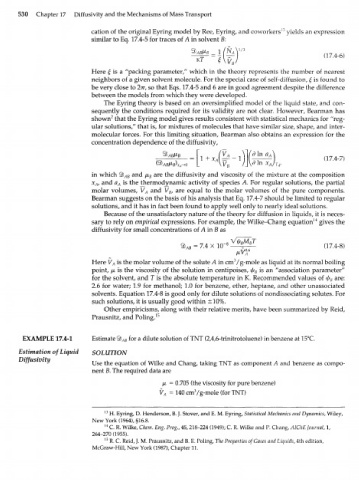Page 550 - Bird R.B. Transport phenomena
P. 550
530 Chapter 17 Diffusivity and the Mechanisms of Mass Transport
cation of the original Eyring model by Ree, Eyring, and coworkers 13 yields an expression
similar to Eq. 17.4-5 for traces of A in solvent B:
1/3
NA
(17.4-6)
KT
VB
Here £ is a "packing parameter/ 7 which in the theory represents the number of nearest
neighbors of a given solvent molecule. For the special case of self-diffusion, £ is found to
be very close to 2тг, so that Eqs. 17.4-5 and 6 are in good agreement despite the difference
between the models from which they were developed.
The Eyring theory is based on an oversimplified model of the liquid state, and con-
sequently the conditions required for its validity are not clear. However, Bearman has
shown 2 that the Eyring model gives results consistent with statistical mechanics for "reg-
ular solutions/' that is, for mixtures of molecules that have similar size, shape, and inter-
molecular forces. For this limiting situation, Bearman also obtains an expression for the
concentration dependence of the diffusivity,
д In а Л
= \1+хЛ^- (17.4-7)
д In х ) т > р
А
in which % AB and /JL B are the diffusivity and viscosity of the mixture at the composition
x , and a is the thermodynamic activity of species A. For regular solutions, the partial
A A
molar volumes, V A and V , are equal to the molar volumes of the pure components.
B
Bearman suggests on the basis of his analysis that Eq. 17.4-7 should be limited to regular
solutions, and it has in fact been found to apply well only to nearly ideal solutions.
Because of the unsatisfactory nature of the theory for diffusion in liquids, it is neces-
14
sary to rely on empirical expressions. For example, the Wilke-Chang equation gives the
diffusivity for small concentrations of Л in В as
= 7.4 x 10" (17.4-8)
3
Here V A is the molar volume of the solute A in cm /g-mole as liquid at its normal boiling
point, ix is the viscosity of the solution in centipoises, ф в is an "association parameter"
for the solvent, and T is the absolute temperature in K. Recommended values of ф в are:
2.6 for water; 1.9 for methanol; 1.0 for benzene, ether, heptane, and other unassociated
solvents. Equation 17.4-8 is good only for dilute solutions of nondissociating solutes. For
such solutions, it is usually good within ±10%.
Other empiricisms, along with their relative merits, have been summarized by Reid,
Prausnitz, and Poling. 15
EXAMPLE 17.4-1 Estimate ЯЬ АВ for a dilute solution of TNT (2,4,6-trinitrotoluene) in benzene at 15°C.
Estimation of Liquid SOLUTION
Diffusivity
Use the equation of Wilke and Chang, taking TNT as component A and benzene as compo-
nent B. The required data are
/JL = 0.705 (the viscosity for pure benzene)
3
V = 140 cm /g-mole (for TNT)
A
13
H. Eyring, D. Henderson, B. J. Stover, and E. M. Eyring, Statistical Mechanics and Dynamics, Wiley,
New York (1964), §16.8.
С R. Wilke, Chem. Eng. Prog., 45, 218-224 (1949); С R. Wilke and P. Chang, AIChE journal, 1,
14
264-270 (1955).
R. C. Reid, J. M. Prausnitz, and В. Е. Poling, The Properties of Gases and Liquids, 4th edition,
ь
McGraw-Hill, New York (1987), Chapter 11.

